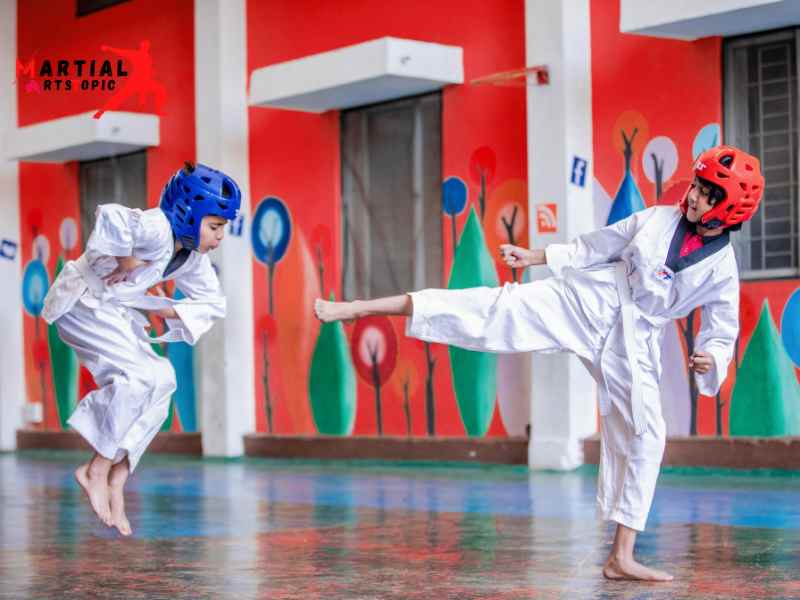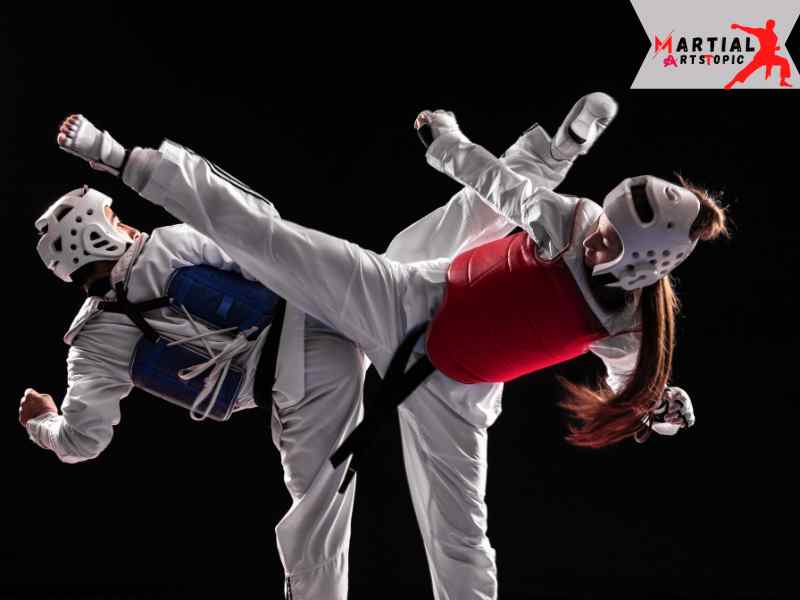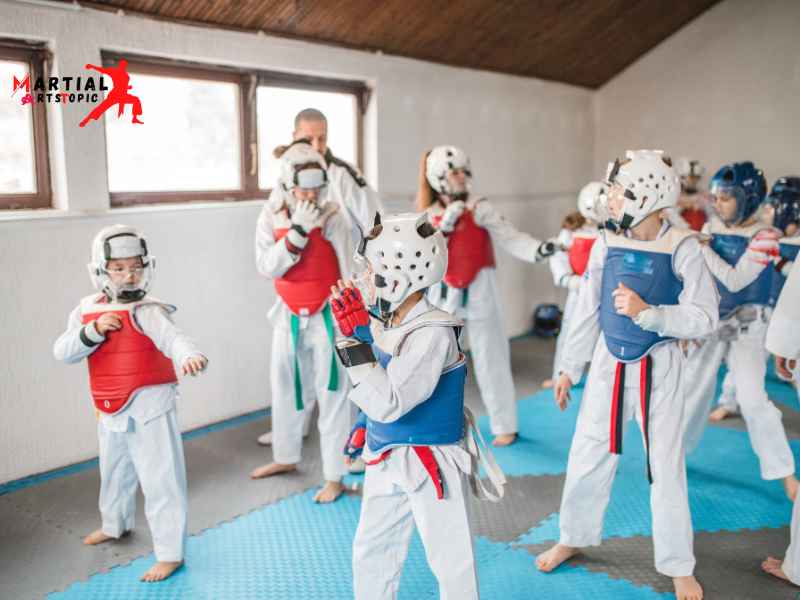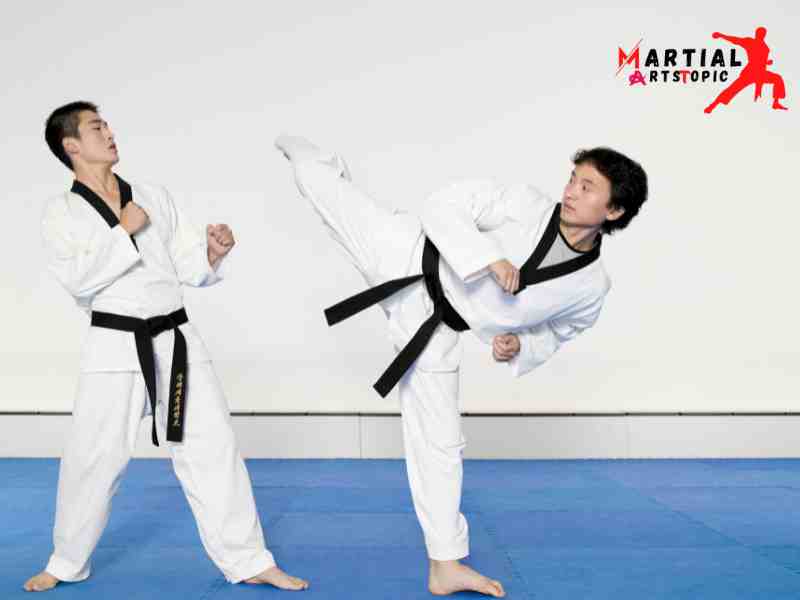
The History and Philosophy Behind Taekwondo Form
The History and Philosophy Behind Taekwondo Forms Taekwondo forms, also known as poomsae, are a fundamental aspect of the ancient Korean martial art. These choreographed sequences of movements serve as a roadmap for practitioners to develop their skills, discipline, and understanding of taekwondo.
History of Taekwondo Forms
We can trace the roots of Taekwondo forms back to ancient Korea, where martial arts were an integral part of the culture. We believe that they developed Taekwondo forms as a way to preserve and pass down the techniques and knowledge of the art from one generation to another. These forms were refined and codified over time, resulting in a comprehensive system that encompasses a wide range of techniques and movements.
Philosophy behind Taekwondo Forms
Taekwondo forms are not merely a series of movements; they embody the core principles and philosophy of Taekwondo. Each form has a specific purpose and serves as a metaphorical representation of different aspects of combat and self-defense. The philosophy behind these forms emphasizes the cultivation of discipline, focus, and respect.
When practicing Taekwondo forms, practitioners are encouraged to concentrate their energy, both physically and mentally, on each movement. This focused approach helps develop a deep understanding of the techniques and their application in real-life situations. The repetitive nature of practicing forms also instills discipline and patience, as practitioners must dedicate countless hours to perfecting each movement.
Significance of Taekwondo Forms

Taekwondo forms play a crucial role in the overall development of a Taekwondo practitioner. They serve as a foundation for learning and mastering various techniques, such as strikes, blocks, kicks, and stances. By practicing forms, practitioners can improve their balance, flexibility, coordination, and overall body control.
Moreover, Taekwondo forms provide an opportunity for practitioners to express their individuality and creativity within the structured framework. They can execute each movement within a form with precision and grace, showcasing the practitioner’s unique style and personal interpretation of the art.
In addition to physical benefits, Taekwondo forms also have a profound impact on the practitioner’s mental and emotional well-being. The focus and concentration required to perform forms help calm the mind and relieve stress. Practicing forms also cultivate self-confidence, self-discipline, and self-control, which are essential qualities not only in martial arts but in everyday life as well.
Unlocking the Secrets
Unlocking the secrets behind Taekwondo forms requires dedication, perseverance, and a deep appreciation for the art. By delving into the history and philosophy of these forms, practitioners can gain a greater understanding of the art’s origins and its purpose in modern times.
Whether you are a beginner or an advanced practitioner, Taekwondo forms are an integral part of your journey. Embrace the discipline, focus, and self-improvement that comes with practicing these forms. Unlock the secrets and let the art of Taekwondo guide you to new heights of mastery.
10 Essential Tips for Perfecting Your Taekwondo Forms
10 Essential Tips for Mastering Your Taekwondo Forms Are you looking to improve your taekwondo forms? Do you want to perfect your technique and become a formidable taekwondo practitioner? Look no further! In this blog post, we will share with you 10 essential tips that will help you perfect your taekwondo forms and take your skills to the next level. Let’s dive in!
- Practice makes perfect: Dedicate regular time to practice your taekwondo forms. Consistency is key with mastering any martial art. Set aside a specific time each day or week to focus on your forms and make it a part of your routine.
- Break it down: Instead of trying to learn the entire form in one go, break it down into smaller sections. Master each section individually before moving on to the next. This approach will help you understand the intricacies of each move and improve your overall performance.
- Focus on accuracy: Pay close attention to the details of each movement. Strive for accuracy in your stances, kicks, punches, and blocks. Practice slow and controlled movements to ensure you execute each technique correctly.
- Develop your strength and flexibility: Taekwondo forms require a combination of strength, flexibility, and balance. Incorporate strength and flexibility training exercises into your routine to improve your overall performance. Work on your core strength, leg strength, and flexibility to enhance your form’s execution.
- Breathe and relax: It’s important to stay calm and composed while performing taekwondo forms. Focus on your breathing and relax your muscles. This will help you maintain control and execute each move with precision.
- Seek guidance from a qualified instructor: A knowledgeable instructor can provide valuable feedback and guidance to help you perfect your taekwondo forms. They can correct your technique, offer tips on improvement, and motivate you to reach your full potential.
- Visualize success: Visualization is a powerful tool that can enhance your performance. Before practicing your forms, visualize yourself executing each move flawlessly. This mental rehearsal will help you improve your muscle memory and boost your confidence.
- Film yourself: Record your practice sessions to analyze your form’s performance. Watch the recordings carefully, identify areas for improvement, and make necessary adjustments. By reviewing your footage, you can spot any flaws or inconsistencies and work towards correcting them.
- Train with a partner: Find a training partner who is also dedicated to improving their taekwondo forms. Practicing with a partner allows you to receive immediate feedback, engage in controlled sparring, and simulate real-life scenarios. It also adds an element of accountability and motivation to your training.
- Stay motivated and have fun: Remember to enjoy perfecting your taekwondo forms. Celebrate your progress, set achievable goals, and stay motivated. Surround yourself with like-minded individuals who share your passion for taekwondo, and remember to have fun along the way.
The Importance of Taekwondo Forms in Martial Arts Training
The Importance of Taekwondo Forms in Martial Arts Training Taekwondo is a martial art that originated in Korea and has gained popularity all around the world. We know it for its dynamic kicks, quick movements, and powerful strikes. One of the essential aspects of taekwondo training is the practice of forms, also known as patterns or poomsae. These forms are a sequence of predetermined movements that have both practical and philosophical significance in taekwondo training.
Taekwondo forms are designed to simulate combat situations against imaginary opponents. They consist of a series of punches, kicks, blocks, and stances that are executed in a specific order. Each form has its unique name and purpose, and practitioners must learn and memorize them as part of their training.
The practice of taekwondo forms offers a multitude of benefits to martial artists of all levels. Here are some reasons why taekwondo forms are essential in martial arts training:
- Discipline and Focus: Learning and performing taekwondo forms require discipline and focus. Practitioners must concentrate on executing each movement with precision and accuracy, which helps improve their mental focus and concentration skills.
- Body Control and Balance: Taekwondo forms require practitioners to perform a wide range of movements that enhance body control and balance. The precise execution of kicks, punches, and stances trains the body to move in a coordinated and balanced manner.
- Strength and Flexibility: The practice of taekwondo forms involves various dynamic and static movements that help develop strength and flexibility. The repetitive execution of kicks and stances improves muscle strength, while the stretching involved in certain forms enhances overall flexibility.
- Self-Defense Skills: Taekwondo forms are not only a means of physical exercise but also a practical application of self-defense techniques. By practicing forms, martial artists learn to execute techniques effectively and efficiently, preparing them for real-life self-defense situations.
- Mental and Emotional Benefits: Taekwondo forms have a significant impact on mental and emotional well-being. The repetitive nature of practicing forms helps reduce stress and anxiety, promoting a sense of calmness and relaxation. Additionally, the mastery of forms instills a sense of accomplishment and boosts self-confidence.
- Cultural Connection: Taekwondo forms have deep cultural significance and serve as a link to the rich history and traditions of Korea. Learning and practicing forms allow practitioners to connect with the heritage of taekwondo and develop a deeper understanding of its roots.
The Benefits of Practicing Taekwondo Forms for Self-Defense

The Benefits of Practicing Taekwondo Forms for Self-Defense Taekwondo, a traditional Korean martial art, has gained popularity worldwide for its dynamic kicks, powerful strikes, and rigorous training. One of the core aspects of taekwondo training is practicing various forms, also known as patterns or poomsae. These forms are a sequence of predetermined movements that simulate combat situations and help practitioners develop their techniques, discipline, and self-defense skills.
- Improved Technique Mastery: Taekwondo forms provide practitioners with an opportunity to refine and perfect their techniques. By practicing the precise movements, stances, and transitions found in forms, martial artists can enhance their overall martial arts skills. Taekwondo forms encompass a wide range of techniques, including punches, kicks, blocks, and strikes, which are essential for self-defense situations.
- Enhanced Physical Fitness: Taekwondo forms require a combination of strength, flexibility, speed, and endurance. The repetitive nature of practicing forms helps improve cardiovascular health, muscular strength, and stamina. Regular practice of taekwondo forms can lead to increased agility, balance, and coordination, all of which are crucial for effective self-defense.
- Mental Focus and Discipline: Performing taekwondo forms demands concentration, mental focus, and discipline. Practitioners must memorize the sequence of movements, execute them with precision, and maintain proper breathing techniques. By consistently practicing forms, martial artists develop mental toughness, improved focus, and discipline, which can be applied in real-life self-defense situations.
- Situational Awareness: Taekwondo forms train practitioners to be aware of their surroundings and simulate combat scenarios. By visualizing opponents and responding with appropriate techniques, martial artists develop a heightened sense of situational awareness. This ability to assess potential threats and react swiftly is invaluable in self-defense situations, allowing practitioners to avoid danger or neutralize threats effectively.
- Increased Confidence: Practicing taekwondo forms builds confidence in practitioners. As they become proficient in executing the movements and techniques, they develop a sense of self-assurance and belief in their abilities. This newfound confidence can be a deterrent to potential attackers and can help individuals feel more secure in their daily lives.
- Self-Defense Skills: Taekwondo forms provide practical self-defense techniques that can be applied in real-life situations. The techniques learned in forms, such as strikes, kicks, and blocks, can be adapted to defend against various types of attacks. Regular practice of taekwondo forms helps martial artists develop the muscle memory necessary to react instinctively and effectively in self-defense scenarios.
- Stress Relief and Emotional Well-being: Engaging in taekwondo forms can be a great way to relieve stress and improve emotional well-being. The physical exertion, focus, and discipline required in practicing forms help reduce anxiety, improve mood, and promote overall mental wellness. Additionally, the supportive and inclusive nature of the taekwondo community can provide a sense of belonging and camaraderie.
Different types of Taekwondo forms
Different Types of Taekwondo Forms: The Art of Martial Movement Taekwondo forms, also known as Poomsae or Hyung, is an integral part of this traditional Korean martial art. These forms combine various techniques, stances, and movements into a choreographed sequence that allows practitioners to practice and demonstrate their skills.
- Koryo Poomsae: Koryo, the first taekwondo form taught to black belts, emphasizes symmetry and balance. It consists of a series of movements that represent the Korean national flag and the 1,000-year-old Koryo Dynasty. Through practicing Koryo, practitioners develop focus, precision, and control over their movements.
- Keumgang Poomsae: Keumgang, meaning “diamond,” is named after the Keumgang-san mountain in Korea, which is considered sacred in Buddhism. This form focuses on power, stability, and the ability to break through obstacles. It incorporates strong, forceful movements that symbolize the unyielding nature of a diamond.
- Taebaek Poomsae: Taebaek, named after the Taebaek mountain range in Korea, represents light and purity. This form emphasizes agility, speed, and fluidity of movements. Practicing Taebaek enhances a practitioner’s ability to transition smoothly between different stances and techniques.
- Pyongwon Poomsae: Pyongwon, meaning “vast plain,” signifies a place where one can cultivate and grow. This form emphasizes balance, calmness, and control over one’s body. Practicing Pyongwon helps practitioners develop a deep understanding of their center of gravity, improving their overall stability and poise.
- Sipjin Poomsae: Sipjin, meaning “10 symbols,” represents the 10 spiritual symbols of longevity derived from the “I Ching” (Book of Changes). This form focuses on expressing strength, flexibility, and precision. Through practicing Sipjin, practitioners cultivate mental and physical endurance, enabling them to perform complex techniques with ease.
- Jitae Poomsae: Jitae, meaning “earth,” symbolizes the continuous changes and adaptability of life. This form emphasizes grounding, balance, and the ability to quickly adjust to different situations. Practicing Jitae helps practitioners develop a strong foundation, both physically and mentally, allowing them to respond effectively to various challenges.
- Cheonkwon Poomsae: Cheonkwon, meaning “sky,” represents the limitless possibilities and expansiveness of the universe. This form focuses on grace, fluidity, and the integration of attack and defense techniques. Practicing Cheonkwon helps practitioners develop creativity and adaptability in their movements.
- Hansu Poomsae: Hansu, meaning “water,” symbolizes the fluidity and adaptability of water. This form emphasizes smooth, flowing movements, as well as speed and power. Practicing Hansu enhances a practitioner’s ability to transition seamlessly between different techniques, mirroring the ever-changing nature of water.
- Ilyo Poomsae: Ilyo, meaning “one,” represents the ultimate unity and harmony within oneself. This form emphasizes simplicity, focus, and the integration of mind and body. Practicing Ilyo helps practitioners develop mental clarity, enabling them to perform with precision and efficiency.
These are just a few examples of the many taekwondo forms that exist. Each form has its own unique characteristics and benefits, contributing to the holistic development of a taekwondo practitioner. Through consistent practice and dedication, practitioners can refine their techniques, improve their physical fitness, and cultivate mental discipline.
The Importance of Taekwondo Forms in Training
Taekwondo forms play a crucial role in the overall development of martial artists. Here are some key benefits of practicing taekwondo forms:
- Technique Enhancement: By repeatedly practicing the movements and techniques within the forms, practitioners refine their stances, kicks, punches, and blocks. This helps improve overall technique, precision, and control.
- Mental Focus: Performing taekwondo forms requires concentration, focus, and discipline. Practitioners learn to synchronize their mind and body, enhancing mental clarity and developing a strong sense of self-discipline.
- Physical Conditioning: Taekwondo forms provide a full-body workout, improving strength, flexibility, agility, and endurance. Regular practice helps build lean muscle, increase cardiovascular fitness, and enhances overall physical conditioning.
- Self-Defense Application: Each movement within taekwondo forms has practical self-defense applications. By understanding the purpose and context of each technique, practitioners develop the ability to apply these movements effectively in real-life situations.
Taekwondo Forms for Beginners: Step-by-Step Guide to Getting Started

Taekwondo Forms for Beginners: Step-by-Step Guide to Getting Started If you’re looking to embark on a martial arts journey, Taekwondo is an excellent choice. Known for its dynamic kicks and powerful strikes, Taekwondo offers a great way to improve fitness, build self-confidence, and learn self-defense techniques. One of the fundamental aspects of Taekwondo is forms, also known as poomsae or patterns.
What are Taekwondo Forms?
Taekwondo forms are a set sequence of movements that simulate real-life combat scenarios. We designed them to develop muscle memory, balance, and coordination while teaching various techniques, such as punches, kicks, and blocks. Each form has its specific set of movements, and practitioners must perform them with precision and focus.
Why are Taekwondo Forms Important for Beginners?
Taekwondo forms are an essential part of training for beginners. They provide a structured way to learn and practice techniques, serving as a foundation for more advanced training. By practicing forms, beginners can improve their stances, fluidity of movement, and overall technique. Additionally, forms help develop mental discipline, concentration, and focus, which are crucial skills in Taekwondo and everyday life.
Step-by-Step Guide to Getting Started with Taekwondo Forms
- Find a Qualified Instructor: To get started with Taekwondo forms, it’s essential to find a qualified instructor or Taekwondo school. A knowledgeable instructor will guide you through the learning process, ensuring that you learn the correct techniques and perform the forms accurately.
- Learn the Basic Stances: Before diving into forms, beginners should familiarize themselves with basic stances used in Taekwondo. These stances include the attention stance, ready stance, front stance, back stance, and horse stance. Mastering these stances will provide a solid foundation for performing forms correctly.
- Start with Beginner Forms: they divide Taekwondo forms into different levels, starting from beginner to advanced. As a beginner, you should start with the basic forms such as Taeguk Il Jang (1st form) or Kicho Hyung Il Bu (Basic Form 1). These forms introduce fundamental techniques and movements and are relatively easier to learn.
- Break Down the Form: Once you’ve chosen a form to practice, break it down into smaller sections. Focus on mastering each section individually before moving on to the next. This approach allows you to grasp the movements and techniques more effectively.
- Practice Regularly: Consistency is key when learning Taekwondo forms. Set aside regular practice sessions and dedicate time to perfecting your forms. Practicing regularly will help improve your muscle memory, balance, and overall performance.
- Seek Feedback: Don’t hesitate to seek feedback from your instructor or fellow practitioners. They can provide valuable insights and corrections to refine your technique and form execution. Embrace constructive criticism as it will help you grow and progress in your Taekwondo journey.
From White Belt to Black Belt: Progression and Significance of Forms in Taekwondo
From White Belt to Black Belt: Progression and Significance of Forms in Taekwondo. Taekwondo forms, also known as poomsae, are a fundamental aspect of training in this ancient Korean martial art. These forms consist of a series of choreographed movements that simulate various combat scenarios, allowing practitioners to practice and refine their techniques. As students progress through the ranks, they learn and master different forms that correspond to their belt level, ultimately culminating in the coveted black belt.
The progression of forms in taekwondo is a symbolic representation of a practitioner’s growth and development in the art. Each form builds upon the skills and knowledge acquired from the previous one, providing a structured framework for learning and advancement. Starting from the white belt, students begin with basic forms that focus on fundamental movements, stances, and strikes.
As students advance to higher belt levels, the complexity and difficulty of the forms increase. The movements become more intricate, incorporating a combination of kicks, punches, blocks, and transitions. These forms challenge practitioners to improve their balance, coordination, speed, and power.
Beyond the physical aspects, taekwondo forms also hold great significance in terms of discipline, mental focus, and character development. Learning and performing forms require concentration, focus, and attention to detail. Practitioners must memorize the sequence of movements and execute them with precision and fluidity, promoting mental clarity and discipline.
Furthermore, taekwondo forms instill important values such as perseverance, self-control, and respect. Through consistent practice and repetition, students cultivate patience and perseverance, as mastering a form may require months or even years of dedicated training. Performing forms also teach practitioners to control their body and mind, promoting self-control and discipline.
Taekwondo forms are not just a series of movements; they carry deep cultural and historical significance. Each form has its own unique name, often derived from important figures or events in Korean history. By practicing these forms, students connect with the rich heritage and tradition of taekwondo, fostering a sense of pride and respect for the art.
In addition to their significance in training and character development, taekwondo forms also play a crucial role in competitions. Poomsae competitions evaluate practitioners’ execution of forms, assessing their technique, accuracy, power, and presentation. Competing in poomsae events allows practitioners to showcase their skills, creativity, and artistry, further enhancing their overall taekwondo journey.
Taekwondo Forms: Unraveling the Hidden Meanings
Taekwondo Forms: Unraveling the Hidden Meanings Taekwondo forms, also known as patterns, poomsae, or hyung, are an essential element of this ancient Korean martial art. These choreographed sequences of movements are not just a display of physical prowess, but they also hold deep philosophical and cultural significance. In this blog post, we will delve into the world of taekwondo forms and uncover the hidden meanings behind them.

Taekwondo forms serve multiple purposes within the practice of this martial art. They are not merely a series of techniques to be memorized and performed; rather, they encapsulate the essence of taekwondo philosophy, history, and combat techniques. Each form has its unique set of movements, stances, and techniques, all carefully designed to develop and refine various aspects of a practitioner’s skills.
The origins of taekwondo forms can be traced back to ancient Korea, where they were developed as a means of preserving and passing on the knowledge of martial arts from one generation to the next. These forms were created by grandmasters who sought to systemize the techniques and principles of taekwondo into a cohesive and structured curriculum. By practicing these forms, students not only learn the physical techniques but also gain insight into the philosophical and cultural aspects of taekwondo.
Taekwondo forms are a visual representation of combat scenarios, with each movement symbolizing a particular attack, defense, or counterattack. Through the repetition of these sequences, practitioners develop muscle memory, speed, and precision in their techniques. Additionally, the intricate footwork and body positioning in the forms help improve balance, coordination, and overall body control.
While the physical benefits of taekwondo forms are undeniable, their hidden meanings lie in the symbolism and philosophy embedded within each movement. The forms often reflect the principles of taekwondo, such as perseverance, discipline, respect, and self-control. They also embody the five tenets of taekwondo: courtesy, integrity, perseverance, self-control, and indomitable spirit.
Moreover, taekwondo forms tell stories of Korea’s rich history and cultural heritage. They named many forms after historical figures, events, or natural elements, such as mountains, rivers, and animals. By learning these forms, practitioners gain a deeper understanding of Korean history, folklore, and traditions.
Unraveling the Hidden Meanings
Beyond the physical and mental benefits, taekwondo forms hold deep symbolic meanings. Each sequence of movements tells a story and embodies different principles and philosophies. Here are a few examples:
- Koryo: This form symbolizes the Koryo dynasty, which ruled Korea for over 500 years. It represents the strength, dignity, and indomitable spirit of the Korean people.
- Taegeuk Il Jang: The first Taegeuk form signifies the beginning of everything. It represents the concepts of creation, yang, and positivity.
- Jitae: This form embodies the earth, symbolizing the importance of stability, grounding, and finding balance in life.
- Hansu: The Hansu form reflects the water element, emphasizing fluidity, adaptability, and the ability to overcome obstacles.
Conclusion
Taekwondo forms, also known as Poomsae, play a crucial role in the practice and development of this martial art. They serve as a foundation for refining techniques, improving balance and coordination, and cultivating discipline and focus. Through the repetition and mastery of various forms, practitioners can enhance their physical abilities, mental resilience, and self-confidence. Moreover, the performance of Taekwondo forms showcases the grace, precision, and power that is inherent in this dynamic martial art. Whether you are a beginner or an advanced practitioner, incorporating forms into your training routine can greatly contribute to your overall growth and proficiency in Taekwondo.
